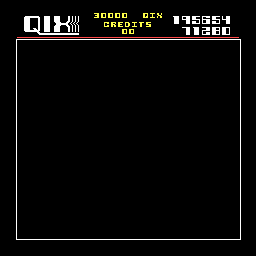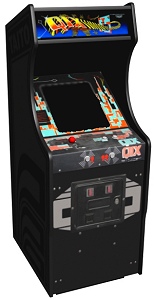 The Game: In an exceedingly abstract and addictive game, you are a marker, trying to claim as much of the playing field as you can by enclosing areas of it. Drawing your boundaries faster is safer, but yields fewer points. A slower draw, which leaves you vulnerable to attack from the Qix and the Sparx, gives you many more points
The Game: In an exceedingly abstract and addictive game, you are a marker, trying to claim as much of the playing field as you can by enclosing areas of it. Drawing your boundaries faster is safer, but yields fewer points. A slower draw, which leaves you vulnerable to attack from the Qix and the Sparx, gives you many more points  upon the completion of an enclosed area. If the ever-shifting Qix touches your marker or an uncompleted boundary you are drawing, you lose a “life” and start again. And the Sparx, which travel only along the edges of the playing field and along the boundaries of areas of the screen you’ve already enclosed, can destroy you by touching your marker. And if you linger too long, a fuse will begin burning at the beginning of your unfinished boundary, and will eventually catch up with you. (Taito, 1981)
upon the completion of an enclosed area. If the ever-shifting Qix touches your marker or an uncompleted boundary you are drawing, you lose a “life” and start again. And the Sparx, which travel only along the edges of the playing field and along the boundaries of areas of the screen you’ve already enclosed, can destroy you by touching your marker. And if you linger too long, a fuse will begin burning at the beginning of your unfinished boundary, and will eventually catch up with you. (Taito, 1981)
Memories: Possibly the single most abstract thing to hit the arcade until Tetris, Qix was an underground arcade hit. Its bizarre game play, which defies any attempt to attach a narrative element or even define the Qix and sparx as anything other than “your opponents,” is enormously addictive. To this day, it’s still one of my favorites, but it’s nearly impossible to explain the game to anyone who wasn’t there to see it for themselves.
 Qix, it seems, was only ever translated into Atari 5200 form in its day, as it would have been incredibly difficult to create a passable Qix adaptation for the Atari 2600, even though, just before Atari stopped supporting its original breadwinner, a 2600 Qix was announced but never hit the store shelves. Not long after the arrival of Nintendo’s Game Boy, there was a very accurate and fun version of Qix – albeit on a smaller playing field – which was well suited to the LCD game’s display. And, of course, it seemed like the Qix itself starred in one of the original Windows 95 screen savers.
Qix, it seems, was only ever translated into Atari 5200 form in its day, as it would have been incredibly difficult to create a passable Qix adaptation for the Atari 2600, even though, just before Atari stopped supporting its original breadwinner, a 2600 Qix was announced but never hit the store shelves. Not long after the arrival of Nintendo’s Game Boy, there was a very accurate and fun version of Qix – albeit on a smaller playing field – which was well suited to the LCD game’s display. And, of course, it seemed like the Qix itself starred in one of the original Windows 95 screen savers.
Taito released a slightly more difficult “tournament” version of Qix in kit form, intended for  arcade owners to replace the chipsets themselves. But the only real spinoff of Qix came later, with the arrival of Super Qix, which remained true to the play of the original game, but embellished the graphics by transforming the Qix from a screen saver into a cute, animè-inspired dragon character. (This version was also sometimes called Castle Qix.) When the abstractions were lost, Qix was somehow less ambiguous and less fun in its new incarnation.
arcade owners to replace the chipsets themselves. But the only real spinoff of Qix came later, with the arrival of Super Qix, which remained true to the play of the original game, but embellished the graphics by transforming the Qix from a screen saver into a cute, animè-inspired dragon character. (This version was also sometimes called Castle Qix.) When the abstractions were lost, Qix was somehow less ambiguous and less fun in its new incarnation.
